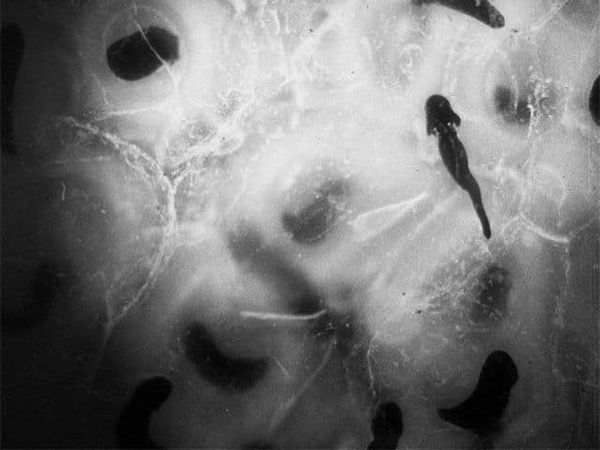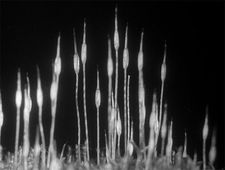 |
| Stuart A Staples says: "I think this film has been such a gradual process and what it has instilled in me is a sense of patience and commitment" Photo: Courtesy of BFI |
In conversation with Eye For Film, Staples and Reeve reflected on the origins of the project, the time consuming journey and the deep collaboration with Smith’s work. They also discussed the importance of creating something that not only offered a window onto the past, but which could engage with the contemporary world.
What was the genesis of the film? Where did it first begin for you?
Stuart A Staples: It came from a glimpse of one of his microscopic films and then from there I just felt that I'd like to find out more. I found out he was this guy that was involved in Secrets Of Nature and that there were a certain amount of films available from the BFI on DVD. And they just felt kind of real - there was a certain element, a real musical connection to the films, where they start off in the very micro-world of these evolving forms that I found to be incredibly musical. I think it started from there. And then I found a connection with certain musicians, Christine Ott and Thomas Belhom.
We had a recording session where we were just exploring ideas with certain films I had prepared, chopping them down to their micro-form, I suppose. Then I got to a certain point where I had lots of exciting things, but I didn't know where it was going as a whole, and that's when I asked David to be involved. The last two years have been more about performing the whole experience from where it starts, the tempo of it and getting it from there to here. And it's not an easy thing when you are working with something that's so fluid and so abstract, to get to the end and think, “I feel as though I have experienced this,” rather than as it being a collection of Percy's films with some music. But I think we looked for something deeper than that.
When Stuart approached you what was your first impression of the project?
 |
| Stuart A Staples: "It's about the footage itself and that makes it very different to other archive projects I've seen in that way" Photo: Courtesy of BFI |
So for you the music is almost ingrained within the images themselves and you can't separate the two?
SS: I think that's the essence of the films and where he came from was seeing something and saying, “Well that really makes me want to make some music for this moment.” So if you start from that point, then I think you have to be true to that. You can't avoid it… That's the spark. When you make things you sometimes have to keep a hold of what it was that made you want to do this because it's not a pragmatic choice. You’ll have seen something that made you go, “What was that.” And I think that's the starting point, and that is the essence. You always have to keep that little flame within it - where everything goes around it - and protect it because if that disappears, things will float around and become ambivalent.
One of the important aspects of the film is that it looks back to early cinema, during a time when we are suffering a disconnect with film history. Do you feel that we are seeing a disconnect and how do you view the importance of actively ensuring we continue to explore the heritage of film?
SS: What I take from the way you are thinking is there is something about this man’s work that is really authentic. It has got so much soul, so much passion, belief and commitment to it. It is unavoidable and I think, from my point of view, it was always respecting that without being beholden to it. There's almost so much drapery of the time for the Secrets Of Nature films, to show them as these educational things, whereas I wanted to concentrate on him in his laboratory and studio on his journey. And that was how it started really, just by trying to connect with that pure cinema and pure photography that he was working on.
I think it's really important to respect that, but at the same time it is equally important to be able to show that as something that is relevant to now, to the world that we are living in because it’s not an archive project that takes this clip to describe this moment. It's about the footage itself and that makes it very different to other archive projects I've seen in that way. It is a tribute and it's almost curating in a way, to show something that allows you to go, “Wow, that's fantastic!” I think for the Secrets Of Nature films you have to step back into the 1920s to actually judge what it is they are about.
It is said that we can't judge the past according to the present. Our exposure to the moving image is vastly evolved compared to the period in which Smith was working. Within our experience of the films there will inevitably be a connection offset by a disconnect.
SS: But it's also about its own thing as well, and it's something that says, experience this. Then behind that or within that is the original photography of Percy and some of the great music. It is a thing of itself, but overall it's also very true to him. Maybe it's even more true than dressing it up for an educational film because it allows it to be, this was the moment he was into. The film doesn't try to describe or tell you anything. It's just about that moment of going through the journey with the organism or plant.
DR: The weeks and months he spent trying to get the moulds to grow and failing, and then trying different techniques. And then the point that he saw the spore and then seeing the end result. And then seeing that film projected for the first time must have been incredible. He was seeing that miracle himself for the first time and I don't think anyone had really seen that before.
 |
| Stuart A Staples: "It was always feeding what we were doing and that's what gives me my belief in it because we just always ended up coming back" Photo: Courtesy of BFI |
DR: And I think his house became condemned because of that film. He'd created such a perfect environment for mould to grow that he couldn't stop it in the end.
SS: So he had to move out.
Speaking to Terence Davies, he said a film, Goes out into the world, and it has to either survive or die.” But art has the capacity to be rediscovered and resurrected, which in and of itself is the act that Minute Bodies undertakes - to resurrect Percy Smith’s work for a new generation.
SS: And there is technology as well. We wouldn't have been able to make this film 15 years ago, it would have been impossible. But the technology is so accessible to explore visual ideas now and to experiment. What gives me my belief in Minute Bodies is that for me at the beginning, and then myself and David, there was something that always brought us back to it. There were so many moments we could have just drifted away. We could have just had a week together working on it, taken it to the next step, but every time we did that it asked us to do something else. It was always feeding what we were doing and that's what gives me my belief in it because we just always ended up coming back. We both had to fight for time and a lot of our time over the past couple of years has been spent on this film, and ultimately it means something or the belief inside it says something.
German filmmaker Christoph Behl once said to me: “You are evolving, and after the film you are not the same person as you were before.” Do you perceive there to be a transformative aspect to the creative process?
SS: I've always felt that from working with Claire Denis. On every film I've worked on with her, I’ve always felt changed by it in a certain way. I think this film has been such a gradual process and what it has instilled in me is a sense of patience and commitment. It's kind of, I don't know, it has cemented something inside me that wasn't maybe as strong before. You can't help but believe in this guys work and it is just so irresistible because ultimately it has so much truth in it.
DR: I agree, and I think at the end of the day like everything we work on or anything you come across in life, it could be said to be in some way transformative. If I think about where I was at the beginning of the process to now, it has been such a long and drawn out one. But it is looking back at someone else's work and over a period of years getting to know not just his work, but a bit about the man himself, and a bit about the science of what he was doing. In that sense it probably will bleed itself into my next projects in a different way. There will be something different, but what that is yet I don't know.
Minute Bodies: The Intimate World Of F Percy Smith premiered at the 60th London Film Festival. The film will have selected screenings and a BFI DVD release in 2017, alongside a soundtrack release.





















